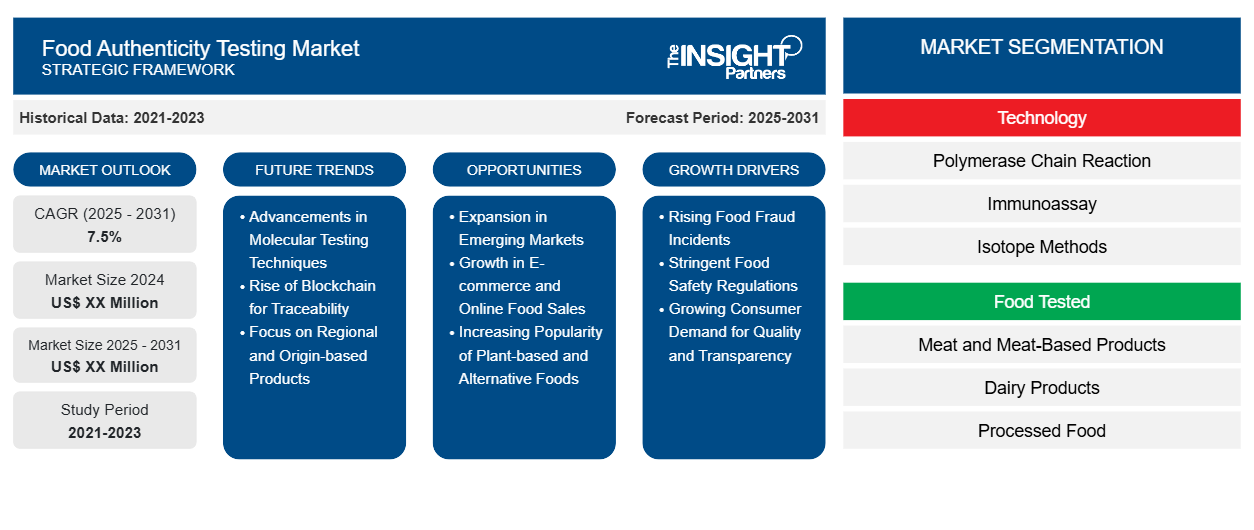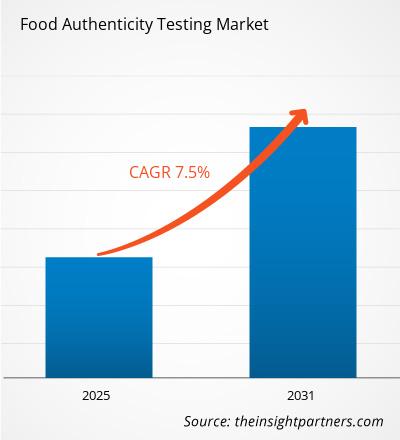The Food Authenticity Testing Market is expected to register a CAGR of 7.5% from 2025 to 2031, with a market size expanding from US$ XX Million in 2024 to US$ XX Million by 2031.
The food authenticity testing market report is segmented by Technology (Polymerase Chain Reaction (PCR), Immunoassay, Isotope Methods, ELISA, and Others) and Food Tested (Meat and Meat-Based Products, Dairy Products, Processed Food, Ingredients, Cereals, Grains, Pulses, and Others). The market size and forecast at global, regional, and country levels for all the key market segments are covered under the scope. The report offers the value in USD for the above analysis, segments, regions, and countries. The report covers market trends, as well as market dynamics such as drivers, restraints, and key opportunities. The report also covers industry landscape and competition analysis covering market concentration, heat map analysis, prominent players, and recent developments in the market.
Purpose of the Report
The report Food Authenticity Testing Market by The Insight Partners aims to describe the present landscape and future growth, top driving factors, challenges, and opportunities. This will provide insights to various business stakeholders, such as:
- Technology Providers/Manufacturers: To understand the evolving market dynamics and know the potential growth opportunities, enabling them to make informed strategic decisions.
- Investors: To conduct a comprehensive trend analysis regarding the market growth rate, market financial projections, and opportunities that exist across the value chain.
- Regulatory bodies: To regulate policies and police activities in the market with the aim of minimizing abuse, preserving investor trust and confidence, and upholding the integrity and stability of the market.
Food Authenticity Testing Market Segmentation
Technology
- Polymerase Chain Reaction
- Immunoassay
- Isotope Methods
- ELISA
Food Tested
- Meat and Meat-Based Products
- Dairy Products
- Processed Food
- Ingredients
- Cereals
- Grains
- Pulses
You will get customization on any report - free of charge - including parts of this report, or country-level analysis, Excel Data pack, as well as avail great offers and discounts for start-ups & universities
Food Authenticity Testing Market: Strategic Insights

-
Get Top Key Market Trends of this report.This FREE sample will include data analysis, ranging from market trends to estimates and forecasts.
Food Authenticity Testing Market Growth Drivers
- Rising Food Fraud Incidents: Food fraud, including the mislabeling of ingredients and adulteration, is a significant driver for the food authenticity testing market. As consumers and businesses demand more transparency, testing services are required to ensure products' authenticity. This trend is further fueled by high-profile fraud cases, driving the need for advanced testing to protect public health and maintain trust in the food supply.
- Stringent Food Safety Regulations: Governments and international organizations are increasingly enacting strict food safety and labeling regulations. These regulations, which require proof of product authenticity, are compelling food manufacturers, retailers, and importers to invest in testing services. The need to verify food origins and ensure compliance with food safety standards contributes significantly to the growth of the food authenticity testing market.
- Growing Consumer Demand for Quality and Transparency: Consumers are more informed and concerned about food quality, sourcing, and authenticity. With the rise of premium products like organic, fair-trade, and specialty foods, there is a heightened demand for verification of claims. As a result, food manufacturers are adopting authenticity testing to meet consumer expectations for transparency and ensure the integrity of their products.
Food Authenticity Testing Market Future Trends
- Advancements in Molecular Testing Techniques: Molecular testing methods such as DNA barcoding and polymerase chain reaction (PCR) are becoming more popular in the food authenticity testing market. These techniques offer high precision and are capable of detecting even small amounts of adulterants or mislabeled ingredients. The trend toward molecular testing is driven by the need for more accurate and efficient ways to authenticate food products.
- Rise of Blockchain for Traceability: Blockchain technology is increasingly being integrated into food supply chains to enhance transparency and traceability. By providing an immutable record of the product’s journey from farm to table, blockchain supports the authentication of food claims. This trend promotes the use of food authenticity testing as part of broader efforts to build trust and improve the integrity of food products.
- Focus on Regional and Origin-based Products: Consumers are increasingly interested in foods with geographical indications (GI), such as region-specific wines, cheeses, and olive oils. As a result, there is a growing emphasis on testing the authenticity of these products to verify their true origin and ensure they meet the specified standards. This trend is driving increased demand for food authenticity testing services in the premium and specialty food sectors.
Food Authenticity Testing Market Opportunities
- Expansion in Emerging Markets: Emerging economies are witnessing a rise in consumer demand for safe, high-quality food, providing opportunities for food authenticity testing services. As these regions adopt stricter food safety regulations and consumers become more discerning, there is a growing need for testing solutions to verify food authenticity, creating significant market opportunities for providers in these developing markets.
- Growth in E-commerce and Online Food Sales: The rapid growth of e-commerce and online food sales presents new opportunities for food authenticity testing. With more consumers purchasing food online, verifying product authenticity becomes crucial to prevent fraud. E-commerce platforms and food sellers are seeking reliable testing solutions to ensure that the products they sell meet consumer expectations for authenticity and quality.
- Increasing Popularity of Plant-based and Alternative Foods: The rise of plant-based and alternative food products, such as plant-based meats and dairy substitutes, is creating new opportunities for food authenticity testing. As these markets grow, ensuring that products are accurately labeled and free from contamination or misrepresentation becomes vital. Testing services focused on these emerging sectors can capitalize on the increased demand for authenticity verification in alternative food products.
Food Authenticity Testing Market Regional Insights
The regional trends and factors influencing the Food Authenticity Testing Market throughout the forecast period have been thoroughly explained by the analysts at The Insight Partners. This section also discusses Food Authenticity Testing Market segments and geography across North America, Europe, Asia Pacific, Middle East and Africa, and South and Central America.
Food Authenticity Testing Market Report Scope
| Report Attribute | Details |
|---|---|
| Market size in 2024 | US$ XX Million |
| Market Size by 2031 | US$ XX Million |
| Global CAGR (2025 - 2031) | 7.5% |
| Historical Data | 2021-2023 |
| Forecast period | 2025-2031 |
| Segments Covered |
By Technology
|
| Regions and Countries Covered |
North America
|
| Market leaders and key company profiles |
|
Food Authenticity Testing Market Players Density: Understanding Its Impact on Business Dynamics
The Food Authenticity Testing Market is growing rapidly, driven by increasing end-user demand due to factors such as evolving consumer preferences, technological advancements, and greater awareness of the product's benefits. As demand rises, businesses are expanding their offerings, innovating to meet consumer needs, and capitalizing on emerging trends, which further fuels market growth.

- Get the Food Authenticity Testing Market top key players overview
Key Selling Points
- Comprehensive Coverage: The report comprehensively covers the analysis of products, services, types, and end users of the Food Authenticity Testing Market, providing a holistic landscape.
- Expert Analysis: The report is compiled based on the in-depth understanding of industry experts and analysts.
- Up-to-date Information: The report assures business relevance due to its coverage of recent information and data trends.
- Customization Options: This report can be customized to cater to specific client requirements and suit the business strategies aptly.
The research report on the Food Authenticity Testing Market can, therefore, help spearhead the trail of decoding and understanding the industry scenario and growth prospects. Although there can be a few valid concerns, the overall benefits of this report tend to outweigh the disadvantages.
Frequently Asked Questions
What is the expected CAGR of the food authenticity testing market?
What are the driving factors impacting the food authenticity testing market ?
What are the key players operating in the food authenticity testing market?
Which is the fastest growing segment based on food tested?
Based on geography, which region held the largest share of the food authenticity testing market?
What is the future trend for food authenticity testing market?
- Historical Analysis (2 Years), Base Year, Forecast (7 Years) with CAGR
- PEST and SWOT Analysis
- Market Size Value / Volume - Global, Regional, Country
- Industry and Competitive Landscape
- Excel Dataset
Recent Reports
Related Reports
Testimonials
Reason to Buy
- Informed Decision-Making
- Understanding Market Dynamics
- Competitive Analysis
- Identifying Emerging Markets
- Customer Insights
- Market Forecasts
- Risk Mitigation
- Boosting Operational Efficiency
- Strategic Planning
- Investment Justification
- Tracking Industry Innovations
- Aligning with Regulatory Trends






















 Get Free Sample For
Get Free Sample For